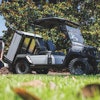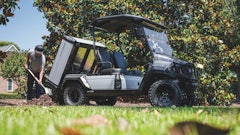
The lawn care and landscape industry is undergoing an exciting evolution as more original equipment manufacturers (OEMs) look to bring battery-powered equipment to market. The industry continues to see advancements in battery-powered turf equipment, including electrified blowers, mowers, edging equipment and more.
However, concerns about factors such as range, run time and performance have given some landscapers pause as they weigh the benefits of integrating battery-powered equipment into their fleets. Both OEMs and landscape professionals are wading through misconceptions around batteries and what battery power can offer in comparison to the traditional engines they are used to operating.
It’s important to address these misconceptions and consider the valuable advantages that battery power offers landscape professionals as they continue to navigate changing emissions regulations and look for ways to optimize their productivity.
Why use battery power in turf equipment?
Historically, gas- and diesel-powered equipment has been the power solution of choice in the turf industry. Recently, there has been a shift in interest as lithium-Ion battery-powered equipment has gained traction around the globe. Compact equipment, such as turf equipment, has been an ideal candidate for the early adoption of battery power. Battery power offers a number of advantages that make it an enticing alternative for landscape equipment. These benefits include reduced noise, vibration, maintenance and emissions.
Battery power has zero emissions, which is a huge regulatory driver for OEMs and end users. Battery-powered equipment can also offer a better user experience because of its quieter operation and minimal required maintenance, which is an attractive benefit for landscape professionals whose livelihoods depend on equipment uptime.
For commercial cutters, the reduced noise of battery-powered equipment can deliver a competitive advantage and allow them to gain contracts with clients that may have stipulations or preferences around emissions and noise levels, like municipalities, schools and hospitals.
Another big driver for the adoption of battery power by landscaping professionals is mitigating the cost of fuel. For professional cutters who have to fuel up an entire trailer full of equipment every day, battery power can help benefit the bottom line of their business as gas prices continue to fluctuate and increase their productivity due to less downtime.
Busting common battery myths
There are a lot of misconceptions when it comes to the power and performance of battery power, especially when compared to its traditional engine counterparts. For example, it’s often thought that batteries offer lower power compared to traditional engines. This is because of some early iterations of lead-acid battery-powered equipment, as well as choices OEMs have made where they sacrificed performance for less battery on board or mislead users by basing run time on some optimal use case. In reality, when properly spec’d for an application, battery power is capable of the same or greater performance to gasoline-powered equipment.
Another misconception is that battery power can’t handle the elements. It’s especially important for professional landscapers to understand the battery solutions available on a particular product. There are battery options available that can actually perform in harsher conditions than an engine could. Batteries are rated with an ingress protection number that indicates the level of dust and water exposure they can handle. It is important to understand that number to know what a particular machine is capable of and how you need to care for it.
Perhaps the most important misconception to clarify is around safety. Not all batteries are created equal—especially when it comes to the advanced chemistry and technology that make up today’s lithium-Ion batteries. There are numerous variations in design and chemical composition when producing a lithium-Ion battery pack.
Understanding what a battery manufacturer has done to design in passive propagation resistance, which is preventing the spread of what happens if one cell inside a battery has an issue, is key to understanding your investment. There needs to be multiple layers of safety to properly account for this.
Considerations for electrifying equipment
Including battery chemistry, sizing, overall power, run time and life expectancy, there is a lot for OEMs to consider when selecting power sources for their electrified products. The power and lifespan of a specific piece of battery-powered equipment will vary greatly depending on the battery specifications and the application for which it’s being used.
When it comes to electrification and making the transition to battery power, both OEMs and end users express concern about equipment providing the run time that's needed while balancing costs. Users need to understand that work conditions play an immense role in the run time of a product, making it hard for OEMs to give a specific number.
With mowers, for example example, long, wet grass can use more than twice the energy as shorter, dryer grass. Blade selection is also a huge part of run time, with higher lift blades using more energy than flatter blades. Electrified equipment also opens the door for much better efficiency in some equipment, eliminating idling and only using energy when actually doing work. Proper battery selection and sizing will be critical to broader adoption, particularly in a market like the lawn care and landscape industry where contractors don’t have room for unscheduled downtime.
Equipment with a high load and run time that is sized with too small a battery can leave the end user dissatisfied. It is important for OEMs to work with skilled electrification partners who can help them understand where and when it makes sense to incorporate battery power and how to do so effectively. Setting expectations is also essential. OEMs can stay ahead of their competition by setting clear expectations for equipment performance and run time. When both the OEM and end user know what they are working to achieve with the electric equipment and the performance they can expect, everyone is happier.
As interest in battery power continues to grow, more OEMs of lawn and landscape equipment are likely to offer battery-powered equipment. The growing availability of electrified turf equipment will empower more landscape professionals and their crews to harness the many benefits of battery power as they address changing regulations and the need to do more with less.





















